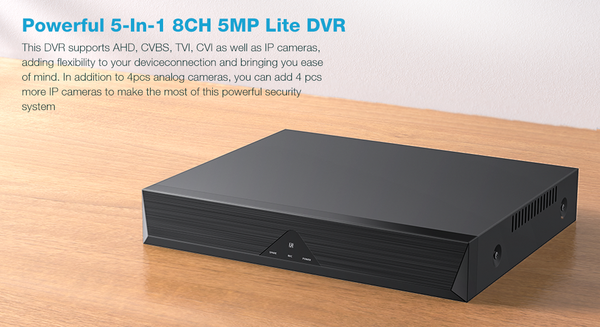Navigation
- Was ist eine drahtlose Überwachungskamera für zu Hause?
- Was sind die Vor- und Nachteile von drahtlosen Überwachungskameras für das Heim?
- Was ist eine kabelgebundene Heimüberwachungskamera?
- Was sind die Vor- und Nachteile von kabelgebundenen Überwachungskameras für zu Hause?
- Wichtige Funktionen, die beim Kauf einer Überwachungskamera für Ihr Zuhause zu beachten sind
- Wo kann man Überwachungskameras für den Heimgebrauch kaufen?
Kabellose Kameras sind derzeit der neueste Trend in Sachen Heimsicherheit. Diese Kameras sind viel mobiler als die herkömmlichen kabelgebundenen Versionen und können überall auf Ihrem Grundstück platziert werden. Allerdings müssen Sie sich viele Fragen stellen, bevor Sie sich für den Kauf einer solchen Kamera für Ihr Zuhause entscheiden. In diesem Artikel erfahren Sie, welche Fragen das sind und welche Vor- und Nachteile diese neue Technologie haben könnte!
Was ist eine drahtlose Überwachungskamera für zu Hause?
Kabellose Heimsicherheitskameras , auch als Wi-Fi-Kameras bekannt. Normalerweise gibt es zwei Möglichkeiten: Zum einen muss die Kamera eine Steckdose verwenden, um das Netzkabel anzuschließen und die Kamera mit Strom zu versorgen. Kabellose Kameras sind nicht kabellos. Zum anderen kann die Kamera drahtloses Internet (Wi-Fi) nutzen, muss aber nicht an eine Stromquelle angeschlossen werden, sondern wird von einer Batterie gespeist. Dies ist eine kabellose Batterie-Sicherheitskamera. Bei einer kabellosen Batterie-Sicherheitskamera müssen Sie die Batterie austauschen oder aufladen, bevor sie leer ist.
Drahtlose Überwachungskameras für den Heimbereich speichern ihre Videodateien häufig auf einem Cloud-Server, sodass Sie von überall mit einer Telefon-App darauf zugreifen können. Einige können Videos auch auf lokalen Medien speichern, beispielsweise auf SD-Karten in Kameras. Drahtlose Kameras sind beliebt, weil sie einfach zu installieren sind und das Herunterladen, Wiedergeben und Anzeigen von Live-Videos mit einem Smartphone oder Computer einfach ist.
Drahtlose Überwachungskameras bieten oft mehr Sicherheitsfunktionen. Sie können unter anderem Videos mit höherer Auflösung aufnehmen, verfügen über Bewegungsverfolgung, Farbnachtsicht, Zwei-Wege-Audio, Gesichtserkennung und Kompatibilität mit Amazon Alexa, Google Assistant und Apple HomeKit. Die Unterstützung für vernetzte Smart-Home-Systeme, mobile Apps und Software ist relativ weit fortgeschritten.

Was sind die Vor- und Nachteile von drahtlosen Überwachungskameras für das Heim?
Vorteil:
- Einfacher zu installieren und einzustellen
- meist einfacher zu bedienen
- Einfache Erweiterung und Hinzufügen weiterer Kameras
- Verwenden Sie immer Cloud-Speicher, damit Sie Ihr Filmmaterial von überall aus ansehen können
Nachteil:
- Für den Cloud-Speicher fällt eine monatliche Gebühr an
- begrenzte Signalreichweite
- Wände, Böden und andere architektonische Elemente können das Signal blockieren
- Kann anfällig für Hackerangriffe sein
Müssen kabellose Überwachungskameras für den Heimgebrauch über WLAN verfügen?
Die meisten drahtlosen Überwachungskameras für den Heimgebrauch müssen ein WLAN-Signal aufrechterhalten und mit Ihrem Netzwerk verbunden sein, um Videos aufnehmen und speichern zu können. Wenn Ihr WLAN ausfällt, kann Ihre drahtlose Überwachungskamera keine Informationen an Ihr Mobilgerät senden. Einige Benutzer können jedoch ihr lokales drahtloses Netzwerk erstellen, das nicht ins Internet sendet. Andere können Aufnahmen direkt auf der SD-Karte der Kamera speichern und sie nur auf Anfrage über WLAN in die Cloud senden. Ohne Internetverbindung kann das von der drahtlosen Kamera aufgenommene Video von außerhalb des Hauses nicht angesehen werden.
Eine weitere Möglichkeit, die Kamera ohne WLAN mit dem Internet zu verbinden, ist die Verwendung einer 4G-Mobilfunkdaten-Überwachungskamera. Sie hat keine WLAN-Reichweitenbeschränkung, sodass Sie Live-Videos auch dann aus der Ferne ansehen und herunterladen können, wenn Sie sich am anderen Ende des Landes befinden. Wie zum Beispiel die Campark SC12 3MP Outdoor Wireless 4G LTE Mobilfunk-Überwachungskamera .

Was ist eine kabelgebundene Heimüberwachungskamera?
Ein kabelgebundenes Sicherheitskamerasystem für den Heimgebrauch , auch als DVR-Sicherheitssystem (Digital Video Recorder) bekannt, ist ein Aufnahmegerät mit integrierter Kamera. Kabelgebundene Sicherheitskameras übertragen Video- und Audiosignale über Kabel an den DVR. Das Filmmaterial kann lokal auf dem Hub gespeichert und später angesehen oder an ein Netzwerk außerhalb des Hauses gesendet werden. Über das Netzwerk können Benutzer Videos live oder später ansehen. Die Anzahl der Kameras beträgt normalerweise 4 und kann bis zu 16 betragen. Sie zeichnen rund um die Uhr auf, können für die Fernansicht mit dem Internet verbunden werden und sind fest mit dem Internet und der Stromversorgung verbunden.
Es gibt zwei Arten von kabelgebundenen Heimsicherheitskamerasystemen: herkömmliche DVR-Systeme und neuere NVR-Systeme (Network Video Recorder). DVR-Systeme verwenden Koaxialkabel, um Kameras mit Strom zu versorgen und Filmmaterial aufzuzeichnen, während NVR-Systeme PoE (Kabel über Ethernet) verwenden, um Kameras mit Strom zu versorgen und Video aufzuzeichnen. Sowohl DVRs als auch NVRs können über Ethernet-Kabel mit dem Internet verbunden werden.
NVRs sind fortschrittlicher als DVRs und können Videos in höherer Qualität aufzeichnen. NVRs verfügen auch über einige der gleichen Funktionen wie drahtlose Kameras, z. B. Gegensprechfunktion und Personenerkennung. Campark SC04 3MP 100 % kabellose WLAN-Solar-Überwachungskamera mit HDMI-Ausgang. Basisstationen können als NVRs verwendet werden. Ereignisse oder Videos werden auf der SD-Karte aufgezeichnet, wenn Sie sie einlegen. Verbinden Sie die Kamera über das HDMI-Kabel und eine kabelgebundene Maus direkt über die Basisstation mit dem Monitor und sehen Sie sich dann das von der Kamera aufgenommene Video in Echtzeit auf dem Monitor an. HDMI ist unkomprimiert, um native Bilder in 3MP HD anzuzeigen. Sie benötigen nicht einmal WLAN oder ein Netzwerk, um dieses System zu verwenden!
Kabelgebundene Überwachungskameras werden über ein fest verdrahtetes Kabel mit Strom versorgt. Dieser Strom kann direkt aus einer Steckdose kommen. Oder die Stromversorgung kann über ein Kabel erfolgen, das an den DVR oder NVR angeschlossen ist, ohne dass ein Stecker in eine Steckdose nötig ist. Die meisten kabelgebundenen Systeme verfügen über eine App zum Anzeigen von Filmmaterial auf einem Smartphone, aber Sie können auch einen Computermonitor an das Aufnahmegerät anschließen, um Aufzeichnungen und Live-Videos anzusehen.
Was sind die Vor- und Nachteile von kabelgebundenen Überwachungskameras für zu Hause?
Vorteile:
- Zuverlässiges Signal, kein Signalverlust
- Sicherer, kein Netzwerk-Hacking
- Klare Video- und Audiosignale
- Keine monatlichen Gebühren für Cloud-Speicher
Nachteile:
- Schwierig zu installieren, erfordert oft eine professionelle Installation
- Nicht tragbar.
- Aufwändige Verkabelung
- Mobile Apps und Software sind oft nicht so fortschrittlich oder benutzerfreundlich
- Smart-Home-Systeme wie Google Assistant oder Amazon Alexa können nicht verwendet werden

Wichtige Funktionen, die beim Kauf einer Überwachungskamera für Ihr Zuhause zu beachten sind
Egal, ob Sie eine drahtlose oder eine kabelgebundene Überwachungskamera kaufen, Sie müssen sich überlegen, welche Marke und welches Modell Sie kaufen möchten. Bei dieser Entscheidung sind mehrere Faktoren zu berücksichtigen:
- Bewegungsaktivierung : Eine Funktion, bei der eine Kamera mit der Aufzeichnung und Speicherung des Videos beginnen soll, sobald sie eine Bewegung erkennt. Zeichnen Sie verdächtige Personen und verdächtiges Verhalten auf.
- Smartphone-Benachrichtigungen : Es sollte Push-Benachrichtigungen geben, die an Smartphones oder Tablets gesendet werden können.
- Auflösung : Je höher die Auflösung des von der Kamera aufgezeichneten Videos, desto mehr Details werden Sie sehen. Die meisten heutigen Videokameras bieten Full HD 1080p-Video. Auflösungskameras für Ultra HD 2K- oder 4K-Videos, da sie schärfere, klarere Bilder erzeugen. Full HD ist für die meisten Leute in Ordnung, aber wenn Sie ganz nah herangehen und Gesichter oder Nummernschilder heranzoomen möchten, suchen Sie nach Ultra HD oder UHD mit 8- oder 10-fachen Digitalzoomobjektiven.
- Nachtsicht : Überwachungskameras für den Außenbereich sollten Nachtsicht mit einer guten Reichweite haben, und bei hochwertigen Überwachungskameras stehen auch Farbfunktionen zur Auswahl. Die Erfassungsreichweite nachts ist nicht so groß wie tagsüber, und die Nachtsicht reicht von etwa 9 bis 90 Metern.
- Audio : Mit Zweiwege-Audio können Sie hören und sehen, was vor sich geht, und Sie können über die Kamera mit jedem vor der Kamera sprechen. Die meisten drahtlosen Kameras verfügen jedoch nur über diese Funktion.
- Speicher : Die meisten drahtlosen Kameras speichern ihre Videos auf Cloud-Servern. Die meisten drahtlosen Kameras speichern Videos auf einer SD-Karte in der Kamera oder auf einer separat angeschlossenen Festplatte.
- Sichtfeld : Je breiter das Sichtfeld, desto weniger Kameras müssen installiert werden, um das gesamte Grundstück abzudecken. Ein Sichtfeld zwischen 130° und 180° kann angestrebt werden.
- Design : Wenn Sie möchten, dass Ihre Kamera die Aufmerksamkeit potenzieller Einbrecher auf sich zieht, können Sie sich für eine Außenkamera entscheiden, die größer und auffälliger sein kann und die Aufmerksamkeit der Leute leichter auf sich zieht. Eine Überwachungskamera mit eingebauter Sirene oder Flutlicht kann ebenfalls als zusätzliche Abschreckung dienen. Wenn Sie keine Aufmerksamkeit erregen möchten, können Sie sich für eine Eulen- oder Glühbirnen-Überwachungskamera entscheiden. Ihre Form lässt sich sehr leicht verbergen und ist nicht leicht zu finden.
- Datenschutzfunktionen : Wenn Ihnen Ihre Privatsphäre wichtig ist, suchen Sie nach einer Geofencing-Funktion, die die Kamera ausschaltet, wenn sich Ihr Smartphone im Haus befindet, und sie wieder einschaltet, wenn Sie nicht da sind.
- Sicherheitsfunktion : Die Zwei-Faktor-Authentifizierung ist eine wichtige Sicherheitsfunktion, die Hackerangriffe verhindert. Das bedeutet, dass Sie eine zweite Methode (z. B. einen Telefonanruf, eine E-Mail oder eine Textnachricht) verwenden müssen, um zu bestätigen, dass Sie sich bei Ihrem Konto anmelden.
- Erweiterte Funktionen wie das Festlegen des aktiven Bereichs, die Unterscheidung zwischen Menschen und Tieren, die Gesichtserkennung, Zoomen, Schwenken usw. geben Ihnen mehr Kontrolle über die Aufnahmen der Kamera.
- Kompatibel mit Smart-Home-Systemen : Die intelligente drahtlose Kamera kann mit einem kompatiblen Smart-Home-System kommunizieren, um Ihnen zusätzliche Funktionen bereitzustellen. Wenn Sie beispielsweise in die Smart-Home-Systeme Amazon Alexa, Google Assistant und Apple HomeKit integriert sind, können Sie Sprachbefehle auf intelligenten Lautsprechern mit Bildschirmen oder kompatiblen Fernsehern verwenden, um Sicherheitsaufnahmen, Hauslieferungen und mehr anzuzeigen. Diese Funktionen sind auf bestimmte Modelle von drahtlosen WiFi-Kameras beschränkt.
- Preis : Zu guter Letzt müssen Sie den Preis Ihrer Überwachungskamera berücksichtigen. Sie können drahtlose Kameras für nur 50 US-Dollar finden, wie zum Beispiel die Campark SC11 10 x Hybrid Zoom 2MP Wireless WiFi Light Bulb Security Camera. Sie kostet nur 45,99 Dollar.

Wo kann man Überwachungskameras für den Heimgebrauch kaufen?
Campark hat sich zum Ziel gesetzt, der Branchenführer für kommerzielle Sicherheitskameras zu sein. Das Unternehmen bietet professionelle Ausrüstung und eine Vielzahl von Kameraoptionen, die auf die unterschiedlichen Bedürfnisse der Kunden in einer Vielzahl von Szenarien zugeschnitten sind. Sie können Dome-Sicherheitskameras, Bullet-Sicherheitskameras oder solarbetriebene Sicherheitskameras kaufen. Sie können Außenkameras, Innenkameras und Videotürklingeln kaufen. Wenn Sie nach einer bestimmten Kamerafunktion suchen, werden Sie bei Campark mit ziemlicher Sicherheit eine Kamera finden, die diese Funktion bietet. Campark ist ein Unternehmen, dem Sie vertrauen können, und mit der größten Auswahl an Sicherheitsausrüstung können Sie sicher sein, dass Sie ein Qualitätsprodukt erhalten. Wenn Sie Fragen haben oder Unklarheiten bestehen, können Sie sich gerne an uns wenden.
